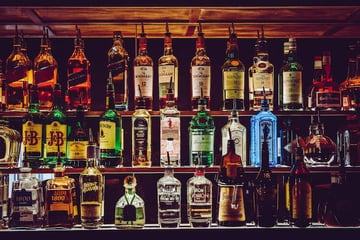 Safeguarding Spirits and Savings: Finding the Best Liquor Inventory App and Bar Inventory App
Safeguarding Spirits and Savings: Finding the Best Liquor Inventory App and Bar Inventory App
In the fast-paced world of bars and nightclubs, the pursuit of efficiency and profitability is unending. To navigate this high-energy environment, many bar and nightclub owners are turning to technology for solutions, particularly the quest to find the Best Liquor Inventory App and the Best Bar Inventory App. In this article, we'll explore the importance of these apps in safeguarding spirits and savings, as well as enhancing liquor control and bar control.
The Significance of the Best Liquor Inventory App
A Liquor Inventory App is a vital component of efficient liquor control in any bar or nightclub. Manual inventory management methods are not only time-consuming but also prone to human errors, making it challenging to keep up with the ever-evolving demands of the industry.
The Best Liquor Inventory App offers real-time tracking of every drop of alcohol in an establishment. This precision ensures that every bottle and keg is meticulously tracked, thereby reducing the risk of over-pouring, spillage, and theft. The result is more precise liquor control, which serves as the foundation for more profitable operations.
Discovering the Best Bar Inventory App for Streamlined Operations
Efficiency is the lifeblood of a well-managed bar or nightclub, and the search for the Best Bar Inventory App plays a critical role in achieving this goal. This technology eliminates the need for time-consuming manual stock counts and data entry, enabling staff to focus on what they do best—serving customers.
The Best Bar Inventory App provides real-time updates on inventory levels, allowing staff to quickly identify available drinks. This minimizes the risk of running out of popular spirits during peak hours, ensuring customer satisfaction and maintaining revenue streams. Moreover, automated alerts for low stock levels simplify the reordering process, eliminating the stress associated with traditional inventory management.
The Quest for the Best: Optimal Liquor and Bar Control
When it comes to liquor and bar control, finding the Best Liquor Inventory App and the Best Bar Inventory App is essential. These apps work in tandem to offer the highest level of precision and efficiency.
The Best Liquor Inventory App ensures that every ounce of alcohol is tracked in real time, minimizing the chances of over-pouring and theft. It also provides data-driven insights into consumption patterns, allowing managers to make informed purchasing decisions.
The Best Bar Inventory App eliminates the need for manual stock counts and data entry, streamlining operations and improving customer service. It also simplifies the reordering process with automated alerts for low stock levels.
Safeguarding Spirits and Savings
In conclusion, the pursuit of the Best Liquor Inventory App and the Best Bar Inventory App is crucial for safeguarding spirits and savings in the bar and nightclub industry. These innovative digital tools provide precise control over liquor inventory and streamline operations, ultimately enhancing profitability.
By preventing over-pouring, theft, and unauthorized consumption, these apps create a more secure and accountable bar environment. Additionally, the data-driven insights they offer empower bar managers to optimize their offerings, make informed purchasing decisions, and enhance profitability.
Investing in the Best Liquor Inventory App and the Best Bar Inventory App is not just a matter of modernization; it's a strategic move toward safeguarding spirits, ensuring savings, and establishing a more efficient and successful bar or nightclub. In the competitive world of nightlife, these apps are the key to staying ahead.
Liquor Inventory Experts
Nick Kaoukis
Recent Posts
Topics: Bar inventory, Scannabar Inventory system, Liquor Inventory savings, Best Bar Inventory app, Best Liquor Inventory app
Crafting Cocktails and Curbing Losses: The Role of a Bar Inventory App
In the world of bars and nightclubs, precision and control are key to success. The modern bar and nightclub industry is dynamic, and with rapidly changing customer preferences, managing inventory and operations efficiently is essential. This is where Bar Inventory Apps come into play, serving as a critical tool in curbing losses, enhancing liquor control, and crafting exceptional cocktails. In this article, we'll explore the pivotal role of Bar Inventory Apps in modern bar management.
Elevating Liquor Control with a Bar Inventory App
A Bar Inventory App is designed to empower bar owners and managers with real-time tracking and control over their liquor inventory. In a fast-paced environment like a bar or nightclub, traditional manual inventory management can be both time-consuming and prone to errors. These issues are particularly problematic when dealing with high-demand items and managing bartender performance.
Bar Inventory Apps bring a new level of precision to liquor control. They allow bar staff to track every drop of alcohol in real time, ensuring that nothing is unaccounted for. This accuracy not only prevents over-pouring and potential theft but also provides valuable data for strategic decision-making.
Streamlining Operations and Efficiency
Efficiency is a buzzword in the bar and nightclub industry, and Bar Inventory Apps play a significant role in achieving it. In busy establishments, every moment counts, and the app eliminates the need for labor-intensive manual stock counts and guesswork.
With real-time updates on inventory levels, bar staff can quickly identify which drinks are available, reducing the risk of running out of popular spirits during peak hours. This level of efficiency is critical for maintaining customer satisfaction and revenue.
Automated alerts for low stock levels simplify the reordering process. This feature ensures that orders are placed promptly, minimizing the chances of stockouts and lost revenue due to understocking. The app not only saves time but also reduces the stress associated with traditional inventory management.
Enhancing Bartender Performance and Accountability
Bar Inventory Apps also contribute to enhancing bartender performance and accountability. These apps record every transaction, from orders to sales, creating a transparent system that promotes accountability. By providing a digital record of each pour, they serve as a deterrent to over-pouring and unauthorized consumption, which can contribute to significant losses.
Additionally, the data generated by these apps allows bar managers to identify trends and patterns in bartender performance. This information can be used for training and improvement, ensuring that all staff members are contributing to the establishment's success.
The Bottom Line: More Profitable Bars and Nightclubs
In conclusion, Bar Inventory Apps are a game-changer for modern bars and nightclubs. These digital tools provide precise control over liquor inventory, streamline operations, and curb losses. By preventing over-pouring, theft, and unauthorized consumption, these apps foster a more secure and accountable bar environment.
Moreover, the data-driven insights from Bar Inventory Apps empower bar managers to optimize their offerings, make informed purchasing decisions, and ultimately enhance profitability. The result is a more efficient and successful bar or nightclub that caters to customer preferences, all while maintaining a competitive edge in a challenging market.
Investing in a Bar Inventory App is not just a move toward modernization; it's a strategic step toward crafting exceptional cocktails, curbing losses, and ensuring long-term profitability in the bar and nightclub industry.
Topics: liquor inventory, Bar inventory, Scannabar Inventory system, liquor inventory system, bar inventory software, bar inventory app, liquor inventory app
Cheers to Efficiency: Streamlining Nightclub Operations with a Liquor Inventory App
Efficiency and precision in liquor and bar management are paramount in the bustling world of nightclubs. To succeed in this high-energy environment, nightclub owners are turning to advanced tools like Liquor Inventory Apps and Bar Inventory Apps. These innovative digital solutions are reshaping the way nightclubs are run, enhancing liquor control, and optimizing bar management. In this article, we'll explore how these apps are contributing to a more efficient nightclub operation.
Elevating 
The foundation of any nightclub's success lies in its ability to control liquor inventory with precision. Traditional manual methods of tracking bottles and kegs often fall short in this fast-paced setting. Liquor Inventory Apps offer an alternative that's revolutionizing the industry.
With a Liquor Inventory App, nightclub owners and managers can enjoy real-time tracking of every drop of alcohol in their establishment. This real-time data isn't just for show; it ensures the accuracy of liquor control. Every ounce is accounted for, minimizing the risk of over-pouring, spillage, and potential theft. It's this level of precision that forms the basis of efficient liquor management.
Streamlining Bar Control with a Bar Inventory App
Efficiency is a nightclub's best friend, and a Bar Inventory App plays a pivotal role in achieving that efficiency. In a fast-paced nightclub, every moment counts. The app eliminates the need for labor-intensive manual stock counts and data entry.
One of the primary advantages of a Bar Inventory App is that it provides real-time updates on inventory levels. Nightclub staff can easily and quickly determine which drinks are available, eliminating the risk of running out of popular spirits during peak hours. This enhanced efficiency is not only vital for customer satisfaction but also reduces stress associated with traditional inventory management.
The app also streamlines the reordering process. Automated alerts for low stock levels ensure that orders are placed promptly, reducing the chances of stockouts. This level of automation not only saves time but also prevents lost revenue due to understocking.
The Synergy of Liquor and Bar Control
When a nightclub integrates both a Liquor Inventory App and a Bar Inventory App, the results are transformative. Imagine having precise insights into which drinks are your top sellers and being able to adjust pricing or promotions accordingly. With real-time data at your disposal, nightclub managers can optimize their offerings, ultimately maximizing revenue while keeping customers satisfied.
These apps also promote a culture of accountability. By digitally tracking every transaction, from orders to sales, they deter employee theft and unauthorized consumption. This not only creates a more secure environment but also fosters trust among staff members, contributing to smoother operations.
In conclusion, the implementation of Liquor Inventory Apps and Bar Inventory Apps is a game-changer for the nightclub industry. These digital tools empower nightclub owners to take precise control of their liquor inventory, streamline operations, make informed purchasing decisions, and ultimately enhance profitability. The result is a well-organized, efficient, and secure establishment that caters to the dynamic needs of nightclub-goers while staying competitive in a tough market. If you're looking to streamline your nightclub operations and boost efficiency, these innovative apps are the way to go. Cheers to a more efficient and profitable nightclub operation!
Topics: Bar inventory, Hotel Inventory, NightClub Management, Bar Management, Liquor Inventory savings, bar inventory app, liquor inventory app
From Bottles to Bytes: Modernizing Bar Control with a Liquor Inventory App The traditional methods of liquor control and bar management have given way to a new era, one that revolves around digital innovation. As bars and nightclubs strive for efficiency and profitability, Liquor Inventory Apps and Bar Inventory Apps are taking center stage. In this article, we'll explore how these apps are redefining bar control and liquor management.
The traditional methods of liquor control and bar management have given way to a new era, one that revolves around digital innovation. As bars and nightclubs strive for efficiency and profitability, Liquor Inventory Apps and Bar Inventory Apps are taking center stage. In this article, we'll explore how these apps are redefining bar control and liquor management.
Embracing Technology for Precise Liquor Control
The heart of any bar operation lies in the control of its liquor inventory. Traditional methods of tracking bottles and kegs have proven time-consuming, prone to human error, and difficult to keep up with the dynamic demands of the industry. Enter the Liquor Inventory App, a digital solution that changes the game.
With a Liquor Inventory App, every ounce of alcohol is meticulously tracked in real-time. This real-time tracking doesn't just provide accurate data on-hand; it also minimizes over-pouring, spillage, and theft. The result? More precise control over your liquor inventory, ensuring that every drop is accounted for. This level of accuracy is the foundation for efficient liquor management.
Efficiency in Bar Control through a Bar Inventory App
Efficiency is the key to a successful bar operation, and a Bar Inventory App is an indispensable tool for achieving this goal. This technology streamlines bar control in several ways.
Firstly, it eliminates the need for manual stock counts and data entry. With real-time inventory updates, bar staff can easily see what's available, reducing the chances of running out of popular drinks during peak hours. This enhanced efficiency not only improves customer service but also eliminates the stress associated with traditional inventory management.
Secondly, the app streamlines the reordering process. Automated alerts for low stock levels ensure that orders are placed in a timely manner, reducing the risk of stockouts. This not only saves time but also prevents lost revenue due to understocking.
The Symbiosis of Liquor and Bar Control
When Liquor Inventory Apps and Bar Inventory Apps work in tandem, the synergy is undeniable. Imagine having precise data on which drinks are your best-sellers and being able to adjust pricing or promotions accordingly. With real-time insights, bar managers can optimize their offerings, ultimately maximizing revenue while keeping customers satisfied.
Furthermore, these apps foster a culture of accountability. By digitally tracking every transaction, from orders to sales, they act as a deterrent to employee theft and unauthorized consumption. This ensures a more secure business environment, builds trust among staff members, and enhances overall bar control.
In conclusion, the integration of Liquor Inventory Apps and Bar Inventory Apps represents a modern approach to bar control and liquor management. These digital tools provide accurate and real-time insights into inventory levels, streamline operations, reduce wastage, and enhance profitability. Bars and nightclubs that embrace this technology gain a competitive edge in an industry known for its dynamism and tough competition. If you're looking to bring your bar into the digital age and modernize your operations, consider the implementation of these innovative apps. Raise your glasses to more efficient and profitable bar control!
Topics: Bar inventory, managing liquor inventory cost, bar control, liquor control, bar inventory app, liquor inventory app
Mastering Mixology and Margins: The Power of a Liquor Inventory App
In the competitive world of bars and nightclubs, the art of mixology and efficient liquor control are paramount for success. To master this balancing act, savvy bar owners are turning to Liquor Inventory Apps and Bar Inventory Apps. These digital tools are becoming the secret ingredients that transform bar management, ensuring optimal control over liquor and bar operations. Let's explore how these apps are changing the game, empowering establishments to mix the perfect cocktail of success.
Precise Liquor Control with a Liquor Inventory App
A Liquor Inventory App is a bartender's best friend when it comes to precise liquor control. Traditional manual inventory methods are not only time-consuming but also prone to errors. With a Liquor Inventory App, each drop of liquor is meticulously tracked in real time. This digital solution ensures that every bottle and keg is accounted for, significantly reducing the likelihood of over-pouring or theft.
Moreover, these apps provide data-driven insights into liquor consumption patterns. Bar managers can access real-time data on which spirits are in high demand and which ones are lagging behind. Armed with this information, they can fine-tune their purchasing decisions, ensuring that the bar is always stocked with the right products. This optimization translates into reduced wastage, more efficient storage, and ultimately, higher profitability.
Efficient Bar Control with a Bar Inventory App
Efficiency is the name of the game in the bar and nightclub business, and a Bar Inventory App is the ticket to streamlined bar control. Bar managers can say goodbye to the hassle of manual stock counts and guesswork. With real-time updates on inventory levels, staff can focus on delivering exceptional customer service rather than getting bogged down in inventory tasks.
The efficiency extends beyond inventory management. Bar managers can set up automated alerts for low stock levels, ensuring that orders are placed in a timely fashion. No more last-minute rushes or stockouts that could disappoint customers and impact sales. This improved efficiency not only saves time but also reduces the stress associated with managing a bustling bar.
The Winning Combination: Liquor and Bar Control
When you combine the capabilities of a Liquor Inventory App and a Bar Inventory App, you get a winning formula for liquor and bar control. Imagine having a complete understanding of which drinks are your top sellers and being able to adjust pricing or promotions based on data-backed insights. Bar managers can develop pricing strategies that maximize revenue while ensuring customers receive value for their money.
These apps also play a significant role in promoting accountability. By digitally tracking every transaction, from orders to sales, they act as a deterrent to employee theft and unauthorized consumption. This not only creates a more secure environment but also fosters trust among staff members, which is essential for smooth operations.
In conclusion, the incorporation of a Liquor Inventory App and a Bar Inventory App is a game-changer for the bar and nightclub industry. These digital tools empower bar owners to take precise control of their liquor inventory, streamline operations, make informed purchasing decisions, and ultimately enhance profitability. The result is a well-organized, efficient, and secure establishment that caters to patrons' preferences while staying competitive. If you're looking to master the art of mixology and margins, investing in these innovative apps is the way to go. Cheers to the future of bar management!
Topics: Bar inventory, managing liquor inventory cost, Bar Management, managing liquor costs, bar inventory software, bar inventory app, liquor inventory app
Sipping Success: How a Liquor Inventory App Transforms Bar Management
In the fast-paced world of bars and nightclubs, effective liquor management is the key to success. That's where the power of a Liquor Inventory App and Bar Inventory App comes into play. These innovative digital solutions are revolutionizing the way bars and nightclubs control their inventory and manage their operations. Let's explore how these apps enhance liquor control and bar management for optimal results.
Streamlined Liquor Control with a Liquor Inventory App
A Liquor Inventory App brings a new level of precision to liquor control. Traditional manual inventory methods can be time-consuming, error-prone, and open to discrepancies. With a Liquor Inventory App, every drop of liquor is meticulously tracked in real time. This technology allows bar managers to maintain accurate records of stock levels, ensuring that popular spirits are always available and minimizing the chances of over-pouring or theft.
Furthermore, the app's data-driven insights reveal consumption patterns and identify high-demand items. Armed with this information, bar owners can make informed purchasing decisions, keeping their shelves stocked with the right products at the right times. The result? Reduced wastage, optimized storage space, and ultimately, enhanced profitability.
Efficient Bar Control with a Bar Inventory App
Effective bar control is the cornerstone of a well-managed establishment. A Bar Inventory App empowers bar managers to take control of their inventory processes like never before. By providing real-time updates on stock levels, the app eliminates the need for manual counts and guesswork. Bar staff can focus on what they do best—serving customers—instead of spending excessive time on inventory-related tasks.
This efficiency extends to ordering and restocking as well. With a Bar Inventory App, the days of last-minute rush orders and stockouts are minimized. Managers can set up automated alerts for low stock levels, ensuring a continuous flow of inventory without interruptions. This streamlined approach not only saves time but also reduces stress and potential lost revenue due to insufficient stock.
The Power of Liquor and Bar Control
Combining the capabilities of a Liquor Inventory App and a Bar Inventory App results in powerful liquor and bar control. Imagine knowing exactly which drinks are your top sellers and being able to adjust pricing or promotions accordingly. With comprehensive data insights, bar managers can develop strategic pricing strategies that maximize revenue while keeping customers satisfied.
Moreover, these apps foster a culture of accountability. By digitally tracking every transaction, from orders to sales, they minimize the chances of employee theft and unauthorized consumption. This creates a more secure environment and builds trust among staff members, ultimately contributing to smoother operations.
In conclusion, the integration of a Liquor Inventory App and a Bar Inventory App is a game-changer for the nightlife industry. By embracing these digital tools, bar and nightclub owners can take full control of their liquor inventory, streamline operations, optimize purchasing decisions, and bolster profitability. The result is a well-organized, efficient, and secure establishment that caters to patrons' preferences while staying ahead in a competitive market. Invest in the future of your bar management with these innovative apps, and sip on the success they bring.
Topics: Bar inventory, Scannabar Inventory system, bar supplies, Bar Management, bar inventory system, bar inventory software, bar inventory app
Enhancing Nightclub and Bar Management: The Key Benefits of Implementing Liquor Inventory Control

In the dynamic and ever-evolving world of the nightlife industry, running a successful nightclub and bar requires meticulous planning, efficient operations, and proactive management strategies. One integral aspect that often goes overlooked is the management of liquor inventory. By employing advanced technology such as a Liquor Inventory App or Bar Inventory App, establishments can unlock a range of benefits that contribute to streamlined operations, improved profitability, and enhanced customer experiences. In this article, we delve into the advantages of implementing liquor inventory control through such applications, emphasizing the significance of liquor and bar control in the realm of nightlife business.
**1. Real-time Tracking and Accuracy:** A Liquor Inventory App or Bar Inventory App provides real-time tracking of every bottle, keg, or case of liquor in your establishment. This not only ensures accurate data on-hand but also prevents instances of over-pouring, spillage, or theft. By maintaining a precise record of inventory levels, bar managers can make informed decisions regarding restocking, purchasing, and pricing strategies.
**2. Efficient Resource Allocation:** Liquor control is crucial for optimizing resource allocation. With a comprehensive liquor inventory system, bar managers can identify slow-moving items and seasonal trends, enabling them to adjust purchasing decisions accordingly. This translates to reduced wastage, minimized storage costs, and increased profitability over time.
**3. Cost Management:** Effective liquor control directly impacts the bottom line. By using a Bar Inventory App, establishments can track their highest-selling and most profitable items. This insight empowers managers to focus on promoting these products and adjusting the pricing of others, thereby enhancing revenue generation and profit margins.
**4. Preventing Unauthorized Consumption:** In a high-energy environment like a nightclub or bar, it's not uncommon for unauthorized consumption to occur. Liquor inventory control helps deter employee theft and unauthorized consumption by establishing a stringent monitoring system. This ensures that every ounce of alcohol is accounted for, reducing potential losses and maintaining a more secure business environment.
**5. Compliance and Accountability:** Regulatory compliance is a paramount concern in the nightlife industry. A Liquor Inventory App aids in maintaining accurate records of purchases, sales, and consumption, which is crucial for adhering to legal requirements. This level of accountability safeguards the establishment from potential legal disputes and penalties.
**6. Data-Driven Decision Making:** With a Bar Inventory App, establishments can harness the power of data-driven decision making. Analyzing inventory data over time can reveal consumption patterns, customer preferences, and peak hours. Armed with these insights, nightclub and bar owners can tailor their offerings and promotions to align with customer demands, leading to increased customer satisfaction and repeat business.
**7. Seamless Integration:** Liquor inventory control applications often offer seamless integration with other management systems, such as point-of-sale (POS) and accounting software. This integration streamlines operations, eliminates manual data entry errors, and fosters an interconnected business ecosystem.
In conclusion, the benefits of taking liquor inventory and implementing a Liquor Inventory App or Bar Inventory App in a nightclub and bar cannot be overstated. From precise tracking and efficient resource allocation to cost management and compliance, these applications offer a holistic approach to liquor control that ultimately drives business success. By embracing technology and data-driven strategies, establishments can elevate their operations, enhance profitability, and create a memorable experience for patrons, solidifying their position as a thriving player in the competitive nightlife industry.
Topics: liquor inventory system, liquor management, liquor inventory app
Liquor Inventory for Hotels: Elevating Guest Experience through Smart Bar Inventory Management In the bustling world of hotels, where hospitality meets luxury and service is paramount, every detail matters. This is especially true for the bar and beverage services within hotels. A flawlessly managed bar not only adds to the overall guest experience but also contributes significantly to the hotel's revenue. To achieve this level of excellence, efficient liquor inventory management is essential. In this article, we'll explore how bar inventory apps and hotel inventory software can transform liquor inventory management within hotels, enhancing both operations and guest satisfaction.
In the bustling world of hotels, where hospitality meets luxury and service is paramount, every detail matters. This is especially true for the bar and beverage services within hotels. A flawlessly managed bar not only adds to the overall guest experience but also contributes significantly to the hotel's revenue. To achieve this level of excellence, efficient liquor inventory management is essential. In this article, we'll explore how bar inventory apps and hotel inventory software can transform liquor inventory management within hotels, enhancing both operations and guest satisfaction.
The Significance of Liquor Inventory Management in Hotels
Effective liquor inventory management is a delicate dance between ensuring that the bar is well-stocked to meet guest demands while avoiding overstocking that ties up capital. Hotels often have multiple bars, each catering to different settings - from a casual lounge to an upscale rooftop bar. This diversity of venues presents a unique challenge in maintaining a consistent and optimized liquor inventory across the property.
Bar Inventory Apps and Hotel Inventory Software: A Seamless Solution
Enter bar inventory apps and hotel inventory software, tailor-made to streamline the complex task of managing liquor inventory in hotels.
Real-time Tracking: Bar inventory apps offer real-time tracking of each liquor bottle, mixer, and garnish. This ensures that inventory data is accurate and up-to-date, making it easier to plan restocking and prevent shortages.
Comprehensive Insights: Hotel inventory software provides in-depth analytics and reports, enabling you to analyze consumption patterns, identify top-performing items, and make data-driven decisions for your bar offerings.
Multi-Venue Management: For hotels with multiple bars and venues, these tools offer the advantage of centralizing inventory data. You can monitor inventory levels across all locations, facilitating better coordination and resource allocation.
Integration with Point of Sale (POS) Systems: Many bar inventory apps seamlessly integrate with the hotel's POS system. This integration ensures that sales data and inventory updates are automatically synchronized, minimizing errors and providing a holistic view of the bar's performance.
Waste Reduction: Efficient liquor inventory management involves minimizing wastage. Bar inventory apps help track spillage, breakage, and over-pouring, allowing you to implement measures to reduce waste and control costs.
Enhanced Guest Experience: Accurate inventory management ensures that guests can enjoy their favorite drinks consistently. Whether it's a classic cocktail or a signature creation, a well-stocked bar adds to the overall guest satisfaction.
Choosing the Right Solution
When selecting a bar inventory app or hotel inventory software for your hotel, consider factors such as user-friendliness, compatibility with your existing systems, customer support, and scalability. Look for solutions that offer customization options to cater to the unique needs of your hotel's bars.
In conclusion, liquor inventory management is a critical component of successful bar operations within hotels. Bar inventory apps and hotel inventory software offer a range of benefits, including real-time tracking, comprehensive insights, multi-venue management, and waste reduction. By embracing these technological tools, hotels can enhance efficiency, optimize inventory, and elevate the guest experience at their bars. Cheers to a well-organized and seamlessly operated bar that becomes a highlight of your hotel's exceptional hospitality!
Topics: Hotel Inventory, hotel supplies, liquor control, bar inventory software, bar inventory app, Hotel Bar Inventory
 Liquor Inventory for Country Clubs and Golf Courses: Enhancing Efficiency with Bar Inventory Apps and Software
Liquor Inventory for Country Clubs and Golf Courses: Enhancing Efficiency with Bar Inventory Apps and Software
For country clubs and golf courses, the bar and beverage service is an integral part of the overall member and guest experience. A well-managed bar not only complements the leisurely atmosphere but also contributes significantly to the revenue stream. Efficient liquor inventory management is a crucial aspect that ensures a seamless and profitable bar operation. In this article, we'll explore how bar inventory apps and software can be game-changers for liquor inventory management in these unique settings.
**Why Liquor Inventory Management Matters**
Properly managing liquor inventory is more than just keeping track of bottles. It involves monitoring stock levels, analyzing consumption patterns, preventing wastage, and optimizing purchasing decisions. Country clubs and golf courses often face fluctuating demand, with busy weekends and events requiring accurate inventory forecasting.
**Bar Inventory Apps and Software: Streamlining the Process**
Enter bar inventory apps and software, designed to simplify and enhance the liquor inventory management process. These tools offer a range of features tailored to the specific needs of country clubs and golf courses.
**Accurate Tracking:** Bar inventory apps allow you to track each bottle and ingredient with precision. Whether it's premium spirits, mixers, or garnishes, you can record consumption, restocking, and even spillage, ensuring your inventory data is always up to date.
**Real-time Updates:** Liquor inventory software provides real-time updates on stock levels. This is especially valuable for clubs and courses with fluctuating demand. The ability to monitor inventory levels at any given moment helps prevent shortages during busy periods and avoids overstocking during quieter times.
**Data-Driven Insights:** These tools generate insightful reports on consumption trends, helping you identify top-selling items and seasonal preferences. This data empowers you to make informed decisions about your beverage offerings, promotional strategies, and pricing.
**Integration with Point of Sale (POS) Systems:** Many bar inventory apps seamlessly integrate with POS systems, allowing for automatic synchronization of sales and inventory data. This integration minimizes manual entry errors and provides a comprehensive view of your bar's performance.
**Cost Control:** Liquor inventory software helps optimize costs by identifying excessive usage or discrepancies. It assists in curbing wastage, implementing portion control, and preventing unauthorized consumption.
**Time Savings:** Traditional manual inventory counting can be time-consuming and prone to errors. Bar inventory apps drastically reduce the time spent on inventory management, freeing up your staff to focus on providing excellent service.
**Enhanced Customer Experience:** Accurate inventory management ensures that popular drinks are always available, preventing disappointments for members and guests. Consistency in service contributes to a positive and memorable experience.
**Choosing the Right Bar Inventory App or Software**
When selecting a bar inventory app or software for your country club or golf course, consider factors such as ease of use, compatibility with your existing systems, customer support, and scalability. Look for solutions that offer mobile capabilities, allowing your staff to conduct inventory checks from anywhere on the property.
In conclusion, effective liquor inventory management is a fundamental aspect of successful bar operations in country clubs and golf courses. Bar inventory apps and software streamline the process, providing accurate tracking, real-time updates, data-driven insights, and integration with POS systems. By embracing these technological solutions, you enhance efficiency, control costs, and ultimately contribute to a superior member and guest experience. Cheers to a well-stocked and smoothly operated bar that becomes a highlight of your establishment!
Topics: Bar inventory, Scannabar Inventory system, liquor inventory system, bar inventory software, bar inventory app, liquor inventory app
Chapter 10: Nurturing Customer Relationships
In the final chapter of this bar journey, we explore the vital importance of nurturing strong customer relationships. Building loyal patrons who keep coming back for more is the key to sustaining the success of your bar in the long run. By focusing on excellent customer experiences and open communication, you can create a thriving community of enthusiasts who become your brand ambassadors.
First and foremost, create a warm and welcoming atmosphere that encourages guests to feel at home. Train your staff to greet every customer with a genuine smile and provide attentive service throughout their visit. Make it a point to remember regulars' names and their favorite drinks, showing that you value their patronage.
Engaging with your customers beyond their visits is equally essential. Leverage your bar's website and social media platforms to keep them informed about upcoming events, new menu additions, and promotions. Regularly respond to customer comments and messages, demonstrating that you value their feedback and opinions.
Now, let's discuss how bar inventory and bar inventory software play a role in nurturing customer relationships. Consistency is key to building trust with your patrons. Bar inventory software helps you maintain inventory levels, ensuring that your customers can enjoy their favorite drinks each time they visit.
Additionally, the software's data insights can offer valuable information on customer preferences. By analyzing sales trends, you can identify popular items and tailor promotions or special offers accordingly. Personalization goes a long way in making customers feel appreciated and valued.
Customer feedback is a goldmine of information. Encourage your patrons to share their thoughts about your bar and its offerings. Consider implementing customer satisfaction surveys or comment cards to gather feedback on their experiences. Take the time to review this feedback and make necessary improvements to address any concerns.
In conclusion, nurturing customer relationships is the cornerstone of a successful and thriving bar. Focus on creating a warm and welcoming environment, engage with your customers both in-person and online, and show them that their satisfaction matters. Utilize bar inventory software to maintain consistency and offer personalized experiences based on customer preferences. By fostering strong connections with your patrons, you'll build a loyal community that will continue to support and elevate your bar for years to come. Cheers to a bright future of lasting customer relationships and continued success!
Topics: Bar inventory, Scannabar Inventory system, managing liquor inventory cost, Bar Management, Liquor Inventory savings, Bar Promotion


